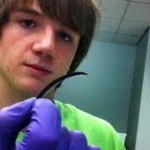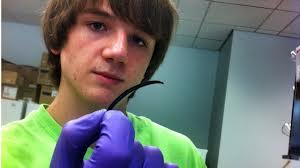Teenager invents cheap and highly selective cancer diagnostics test

If you’re feeling anxious about how U.S. kids lag the world in science and math, read this story of a high school teenager from Maryland who came up with a prize-winning breakthrough that could change how cancer and other fatal diseases are diagnosed and treated.
15 year old teenager Jack Andraka may have revolutionized cancer diagnostics [i]. Andraka has invented a pancreatic cancer test that is 168 times faster and considerably cheaper than the current testing standard in the field: a paper test strip that uses minute changes in conductivity to detect targeted viruses or antigens faster, cheaper and more accurately than today’s standard diagnostics.
Pancreatic cancer is one of the most lethal cancers, with a five-year survival rate of only 6 percent. The diagnosis can be devastating because it is often delivered late, after the cancer has spread.
The novel diagnostic test, according to the inventor, can be applied to other cancers as well, such as detection of ovarian and lung cancer.
The high school student won for his invention an important science prize awarded with $75,000 at the Intel International Science and Engineering Fair in May, the Olympics of youth science, with more than 1,500 entries from 70 countries competing. Andraka also won the Youth Achievement Smithsonian American Ingenuity Award[ii]. He was received by US president Barack Obama and now may feel like a rock star of science.
Andraka has applied for a patent for his test. However, the use of carbon nanotubes in cancer diagnostics isn´t unprecedented[iii][iv] which may be a challenge for the following patent examination.
Andraka says he’s been contacted by four companies, including Quest Diagnostics, about licensing and commercializing the idea.
Andraka was rejected by almost 200 researchers in his search for a lab to do his nanotube strip work until one scientist at at Johns Hopkins University in Baltimore, Maryland (USA), gave him the space to work. Andraka is now carrying out further research at John Hopkins University.
Andraka’s Hopkins mentor Dr. Anirban Maitra, professor in the Johns Hopkins University’s department of pathology who gave Jack use of his lab to craft his invention says “This kid is the Edison of our times. There are going to be a lot of light bulbs coming from him”[v].
Jack Andraka is a wunderkind – the cancer diagnostic test wasn´t his first encounter with the world of science. Andraka entered his first international science competition in the sixth grade and won a silver medal and then won gold medals in the 7th, 8th and 9th grades. When he’s not studying, he’s also competing in math olympics.

Andraka’s diagnostic test[vi] is a test using a filter paper with a layer of carbon nanotubes. hollow cylinders made of carbon atoms. Theses nanotubes are coated with a specific antibody designed to bind with the targeted virus or protein linked to specific cancer types. Andraka’s key finding was that there are noticeable changes in the electrical conductivity of the nanotubes when target proteins bind to the nanotubes and widen their distance slightly. That shift in the spaces between the nanotubes can be measured by simple, conventional electrical meters. The nanotube sensor with a targeted antibody is reported to be extremely sensitive.
The diagnostic test detects proteins associated with certain cancer types, for example mesothelin, a protein commonly used as a biomarker for pancreatic cancer, at a detection limit well below the concentration considered an overexpression of mesothelin consistent with pancreatic cancer. It is reported to be 100 times more selective than existing diagnostic tests, which means no false positives or false negatives. The new test is reported to be able to spot the presence of the cancer-linked protein well before the cancer itself becomes invasive.
Andraka could not have done it without the internet, search engines and free online science.
His parents, he says, never really answered any of the questions they had. Go figure it out for yourself, they would say. “I got really into the scientific method of developing a hypothesis and testing it and getting a result and going back to do it again.”
[iv]Kim JP, Lee BY, Lee J, Hong S, Sim SJ, Biosens Bioelectron. 2009 Jul 15;24(11):3372-8: Enhancement of sensitivity and specificity by surface modification of carbon nanotubes in diagnosis of prostate cancer based on carbon nanotube field effect transistors, department of Chemical Engineering, Sungkyunkwan University, Changan-gu, Suwon 440-746, South Korea,




The most common type of pancreatic cancer, accounting for 95% of these tumors, is adenocarcinoma (tumors exhibiting glandular architecture on light microscopy) arising within the exocrine component of the pancreas. A minority arise from islet cells, and are classified as neuroendocrine tumors. The signs and symptoms that eventually lead to the diagnosis depend on the location, the size, and the tissue type of the tumor, and may include abdominal pain, lower back pain, and jaundice (if the tumor compresses the bile duct).”-;`
With best regards
<http://www.picturesofherpes.co/index.php/